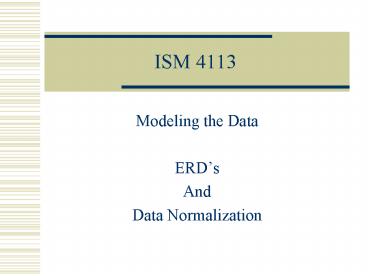ISM 4113 - PowerPoint PPT Presentation
1 / 33
Title:
ISM 4113
Description:
Process modeling focuses on the flow of data. Where does it come ... Basic ERD Symbology. Entity. Relationship. Attribute. Multivalued. Attribute. Associative ... – PowerPoint PPT presentation
Number of Views:49
Avg rating:3.0/5.0
Title: ISM 4113
1
ISM 4113
- Modeling the Data
- ERDs
- And
- Data Normalization
2
Data versus Process Modeling
- Process modeling focuses on the flow of data
- Where does it come fromwhere does it go?
- Where do we store itwhat do we do with it?
- Remember...we dont care how, just what
- Data modeling focuses on the data we are moving
- definitions, structures, relationships,
characteristics - Each plays an essential role in defining the
system - One cannot substitute for the other
- One cannot fully define the system without the
other
3
Six Blind Men and the Elephant
4
Basic ERD Symbology
5
Identifying Entities and Relationships
6
Typical Business Relationships
7
Relationship Syntax
zero or more or one and only one
must be or may be
entity1 relationship entity2
8
Reading Relationships
9
Relationship Complexities
10
Unary Relationship
11
Binary Relationship
12
Ternary Relationship
13
Associative Entity
- Entity whose instance exists only from the
Matches of instances of multiple entities - Inherits its concatenated primary key from the
Parent Entities - May contain attributes that only describe the
Associative Entity
14
Associative Entity
15
Characteristics of a Good Data Model
16
- ERDs and Normal Forms
- (A Review)
17
Three Normal Forms
18
Normal Forms
- 1st
- No repeating groups
- 2nd
- No partial functional dependencies
- No non-key field should be determined by part of
the primary key - By definition a functional dependency can only
occur when a table has a concatenated primary key - 3rd
- No Transitive dependences
- No non-key field should be determined by another
non-key field
19
Data Normalization Process
20
Fixing Normalizations Problems
- Decompose table in error into one or more new
tables
21
An Example in table form
22
Same example
- WorkerAssignment(Wid,Bid,start,name,skill,bonus)
- This is in 1NF (no repeating groups)
- Has a concatenated primary key Wid and Bid
- Can anything be determined with only Wid or Bid?
23
Partial Functional Dependencies
- Wid determines Name,Skill,Bonus.
- So decompose table.
24
2NF Tables
- Assignment(Wid,Bid,Start)
- Worker(Wid,Name,Skill,Bonus)
- Can any non-keys determine any other non-keys?
25
Transitive Dependency
- Skill determines bonus
- So decompose table
26
3NF Tables
- Assignment(Wid,Bid,Start)
- Worker(Wid,Name,Skill)
- Bonus(Skill,Bonus)
27
First Normal Form
28
Second Normal Form
29
Third Normal Form
30
De-Normalization
x
- Once the data is in 3NF we must concern ourselves
with balancing minimum redundancy with maximum
performance. - consider the problem of year-to-date sales
Y-T-D Sales S(Daily Sales to date)
Assume Daily Sales approximately 1,000
transactions per day...
If the report is run on January 2 at day end, the
query needs to add approximately 2,000
transactions to reach a total. If each
transaction takes 0.01 seconds to tally, then the
report will take 2,000 transactions x 0.01
seconds 20 seconds
If, however, the report is requested on December
31 at day end, the query needs to add
approximately 365,000 transactions to reach a
total. Now the time to receive a response will
be 365,000 transactions x 0.01 seconds 3,650
seconds 1.014 hours
31
So
- Certain situations may require the designer to
de-normalize some data elements. - How can we solve this year-to-date thing?
- De-normalize the data elements to allow for the
tabulation and storage of month-to-date totals. - This action will purposely create a file full of
fields that are calculated and thus, not in 3NF. - But...
Total time per monthly calculation 5.07
minutes Total time for y-t-d report on December
31 0.12 seconds
32
Denormalization
33
Fully Normalized ERD































